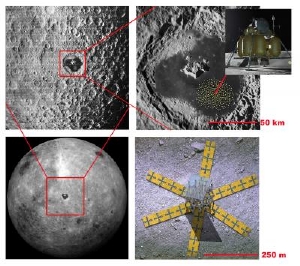Mar 11 2008
A team of scientists and engineers led by the Naval Research Laboratory (NRL) will study how to design a telescope on the Moon for peering into the last unexplored epoch in the Universe's history. NASA has announced that it will sponsor a series of studies focusing on next-generation space missions for astronomy. These studies will contribute to the Decadal Survey, an effort undertaken every 10 years by astronomers and physicists to help establish priorities for future research directions in astronomy and astrophysics. The upcoming Decadal Survey occurs over the next two years.
 The crater Tsiolkovsky is a relatively level region on the far side of the Moon. A lander would deposit a series of rovers, which would then move out and unroll a set of arms containing individual antennas. The astronomical signals picked up by the antennas would be transmitted to back to the central lander for processing.
The crater Tsiolkovsky is a relatively level region on the far side of the Moon. A lander would deposit a series of rovers, which would then move out and unroll a set of arms containing individual antennas. The astronomical signals picked up by the antennas would be transmitted to back to the central lander for processing.
Among the missions to be studied is the Dark Ages Lunar Interferometer (DALI), the NRL-led concept for a telescope based on the Moon and studying an era of the young Universe, during the first 100 million years of its existence. Although the night sky is filled with stars, these stars did not form instantaneously after the Big Bang. There was an interval, now called the "Dark Ages," in which the Universe was unlit by any star. The most abundant element in the Universe, and the raw material from which stars, planets, and people are formed, is hydrogen. Fortunately, the hydrogen atom can produce a signal in the radio-wavelength part of the spectrum, at 21 cm; a wavelength far longer than what the human eye can detect. If these first signals from hydrogen atoms in the Dark Ages can be detected, astronomers can essentially probe how the first stars, the first galaxies, and ultimately the modern Universe evolved.
Because the Universe is expanding, the signals from these distant hydrogen atoms will be stretched (or redshifted) to much longer wavelengths, as large as several meters. While astronomical observations at radio wavelengths have a long history, this portion of the electromagnetic spectrum is now heavily used for various civil and military transmissions, all of which are millions of times brighter than the hydrogen signal that astronomers seek to detect. Additionally, the upper layers of the Earth's atmosphere are ionized (the ionosphere), which introduce distortions into astronomical signals as they pass through on their way to telescopes on the ground.
With no atmosphere and shielding from the Earth, the far side of the Moon presents a nearly ideal environment for a sensitive Dark Ages telescope. In NRL's DALI concept, scientists and engineers will investigate novel antenna constructions, methods to deploy the antennas, electronics that can survive in the harsh lunar environment, and related technology in preparation for developing a roadmap for research and development of a lunar telescope over the next decade. The team will also build on their experience in developing the Radio Observatory for Lunar Sortie Science, a NASA-funded study of a pathfinding array that would be located on the near side of the Moon.
The project leader at NRL, Dr. Joseph Lazio, pointed out that DALI will be one of the most powerful telescopes ever built and will bring us closer than we have ever been to understanding where our Universe came from and where it is going. "Probing the Dark Ages presents the opportunity to watch the young Universe evolve," Dr. Lazio said. "Just as current cosmological studies have both fascinated and surprised us, I anticipate that DALI will lead both to increased understanding of the Universe and unexpected discoveries."
When asked about the program, NRL Senior Astronomer Dr. Kurt Weiler remarked: "Building telescopes on the Moon is clearly a long-term project, but I am very excited about us getting started on this proposal."